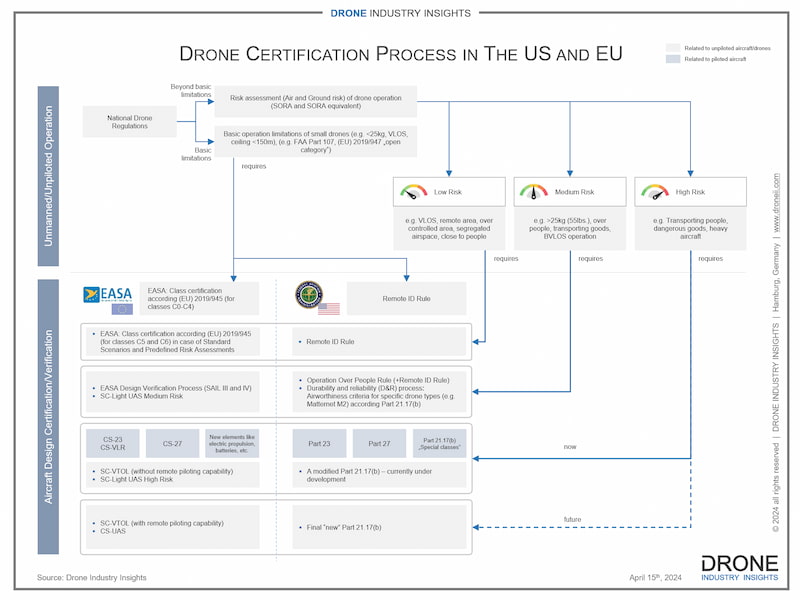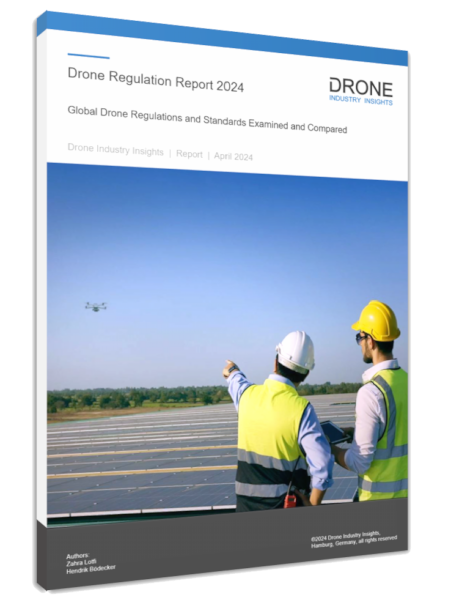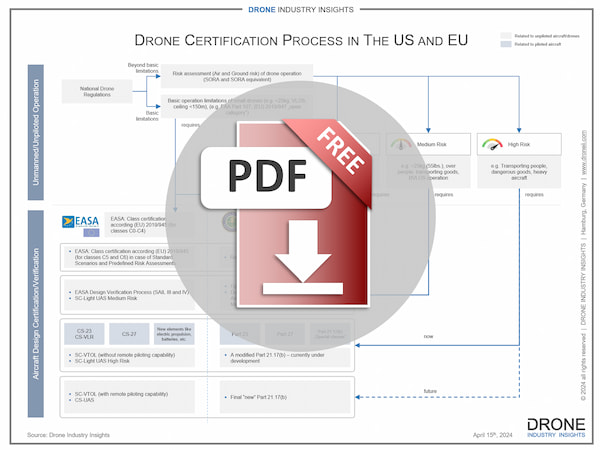Drone Certification: the New Regulatory Focus
The time is near when drone operators will no longer dread the topic of regulation and will instead focus on optimizing their drone certification applications. To be clear, the topic of regulation will never be “easy”, and the certification process is still time-consuming. But those who work with drones or at least follow the industry’s development have long been waiting for necessary regulations to be approved and take effect. Considering the latest and upcoming regulatory advancements, the focus will finally begin shifting toward drone certification to carry out advanced operations.
From Simple Rules to Drone Certification
A certification asserts the airworthiness of a particular category of an aircraft/drone or component, according to its manufacturing design and based on national standards. In the grand scheme of things, drone certification has only recently played a role in drone legislation. Before, there were only general rules for the operation of drones (or worse: no defined rules). However, after the development of stricter regulations as well as the introduction of risk classes, drone certification has become an important step for carrying out any advanced drone operation.
Today, the certification of drones varies between different operational risks. Generally, low-risk drone operations do not require any drone certification. But the higher the risk, the more likely it is that certification(s) is required. By and large, aviation authorities around the globe tend to follow the lead of either or both the Federal Aviation Administration (FAA) and the European Union Aviation Safety Agency (EASA). For low-risk operations in the US, the FAA Part 107 does not require any certified drones because its operational limits are basic. Meanwhile, in Europe, the EASA “open category” requires class-certified drones according to (EU) 2019/945.
Nevertheless, most [commercial] drone operations are higher than small risk and therefore do require certification of drones (i.e. type certification), operations, and/or pilots. Interestingly, certification of drone operators and drone pilots themselves is less at the forefront of efforts than drone certification, though operators often still need to at least be registered in some way.
The Path to Drone Certification: FAA and EASA
The infographic above describes the path for drone certification in both the US and the EU. Small drones, typically under 25kg, operating within visual line of sight (VLOS), and at an altitude of less than 120 meters, adhere to foundational rules such as the FAA’s Part 107 in the US and the Open Category under EASA regulations in the EU. In the US, these regulations require that the drone fulfill the Remote ID rule and in Europe, they must obtain a certification according to (EU) 2019/945 for classes C0 to C4. Once operations surpass these basic limitations, a comprehensive risk assessment that scrutinizes both air and ground risks associated with the drone’s use is mandated (e.g. SORA).
Drone operations are then stratified by risk level. Low-risk activities include VLOS and controlled settings (remote and controlled areas, segregated airspace, etc). In the EU, drones classified as C5 and C6 would require drone class certification according to (EU) 2019/945 if they fall under Standard Scenarios or Predefined Risk Assessments. Unless determined by the competent authority (on a case-by-case basis) low-risk operations do not require additional certification processes beyond remote identification (for both the US and the EU). Note that in many cases the drone and/or pilot will still need to be registered, which is not the same as drone certification.
Medium-risk operations often expand the scope to heavier drones (over 25kg/55 lbs.), BVLOS activities, or those that involve flying over people or carrying goods, necessitating additional drone certifications. EASA requires a design verification process (SAIL III and IV) where it also applies the Special Conditions for Light UAS Medium-Risk. Meanwhile, in the US, compliance with the Operation Over People Rule and the D&R (durability and reliability) process are essential. Through the D&R process, applicants demonstrate [with drone type specific airworthiness criteria] that their drone is reliable, controllable, and safe, and provide the FAA basic assurance that the aircraft will operate as intended.
High-risk operations, which could involve the transportation of people or hazardous materials, call for even more stringent regulations including “21” design requirements rooted in traditional commercial aviation. These then dive into much more extensive regulatory requirements and paperwork. The infographic provides an overview of requirements for high-risk operations for both EASA and the FAA, though it is always imperative to stay up to date on changes and verify which case may apply to a particular drone or operation.
In summary, the evolution of drone regulation over the past 4-5 years shows that the operation of drones would only be possible with classic aviation regulation. In theory, this promises a higher level of safety, but conversely also significantly more organizational and administrative effort (paperwork) for drone manufacturers and operators. Simple and adequate “Means of Compliance” as well as proactive authorities are the keys to success in the drone industry for the near future.
Interested in Commercial Drone Certifications? Check Out Our Latest Drone Regulation Report!
Drone Regulation Report 2024
• 96-page drone regulation report featuring:
• Introduction to regulation + focus on USA and Europe
• Certification & Standards around the world
• Chapter on UTM regulation, framework, and trials
• Drone Readiness Index + deep-dive on 23 countries
2024 Drone Readiness Index: Land Down Under on Top
Although drone certification varies by country, and some countries are ahead of others in terms of their legislation and implementation, a pattern can nevertheless be observed regarding an individual country’s regulatory efforts. The Drone Readiness Index (DRI) is a proprietary metric by Drone Industry Insights that provides a numerical way to analyze and rank various countries’ regulatory developments. To recap, the DRI factors are:
- Operational scope(measuring whether and how drones are able to operate BVLOS, over people, at night, etc);
- Administrative Infrastructure(how much the responsible use of commercial drones is facilitated by insurance requirements, drone regulations, and standard procedures for acquiring flight permission);
- Airspace integration(between manned and unmanned airspaces);
- Social acceptance(how much regulation takes into account data protection and/or privacy issues, which can affect the reputation of drones as a whole within the country);
- Human Resources(how regulations streamline recruitment, training, and certification of humans that work with commercial drones);
- Applicability(having regulations specifically designed for drones and updated in the past 24 months)
In 2022, the DRI was topped equally by Australia, Belgium, and Norway. Then, in 2023, the UK made enough gains to tie with Australia for the top spot, followed by 9 other countries with the same score. Now, for 2024, Australia stands alone in the top spot as the leader for regulatory developments (with a score of 72 out of 100 points on the index). Among the factors placing it on top are the developments of UTM frameworks, guidelines for vertiport design, regulations for night operations, and new advisory circulars.
With a score of 66 points, the second place is technically shared by Canada and Spain, though Canada made more positive changes in general and is therefore placed above Spain in the ranking. The biggest improvements in ranking since last year were made by Switzerland, Poland, and Germany, which have entered the top 10. New countries that were added to this year’s index are Colombia, Ireland, Malawi, Thailand, and Vietnam.
Recent Regulatory Developments around the World
Most recently, the European Commission adopted a regulatory package, giving the go-ahead for VTOL operations and air taxis. Though this does not mean you will be seeing eVTOLs around the Paris Olympics (which was an ambitious goal early on), it does represent a strong milestone for the future operation of these vehicles. In other EASA news, new drones placed on the market after January 1st, 2024 must have a C classification marking to be used in the open category. Remote Identification for drones also became mandatory through this regulation, which was slightly ahead of the FAA’s delayed deadline for Remote ID (that also passed in March 2024).
Another important publication was the FAA’s report on UAS Detection and Mitigation, which aims to promote safe and widespread drone operation while simultaneously not interfering with national airspace. In the UK, the Civil Aviation Authority released an interesting statement regarding drone shows, where the display of logos or products is ‘likely a contravention’ but “shapes or animals would likely be acceptable.” It is also worth mentioning that despite ongoing regulatory work for the specific category (originally based on the European framework), the UK’s open category still enjoys an extension period lasting until 2026.
Elsewhere in the world, there were also plenty of headlines about drone certification and regulation. In Australia, it was announced drones can now operate above populated areas using ParaZero safety systems. Meanwhile, an updated drone regulation in Oman requires legal entities to be registered before applying for a drone license and introduces a new punishable offense regarding the operation of drones without permission. In Canada, there were proposed amendments to decrease administrative burdens for drone certification, while in India a government-issued proof of identity or address is now required of drone operators.
In summary, the past year has seen plenty of advancement in both the establishment of regulations and the processing or drone certification. This means that operators will soon stress less about waiting for the former and can shift their energy toward streamlining the latter.
Download our FREE Drone Certification USA/Europe Infographic
Our Infographic about drone certification in the USA and Europe provides a roadmap explanation of the process to obtain certification based on operation type. These rules have been determined by EASA and the FAA and are accurate as of April 2024

Besides his financial oversight, Hendrik is an expert in aviation law and UAV regulation with more than 10 years of experience. Not only does he consult on all regulation questions, but Hendrik also writes the yearly drone investments report. Prior to launching DRONEII, at Lufthansa Technik he was the single point of contact to Civil Aviation Authorities (CAA) of Germany, Middle East and Asia.





